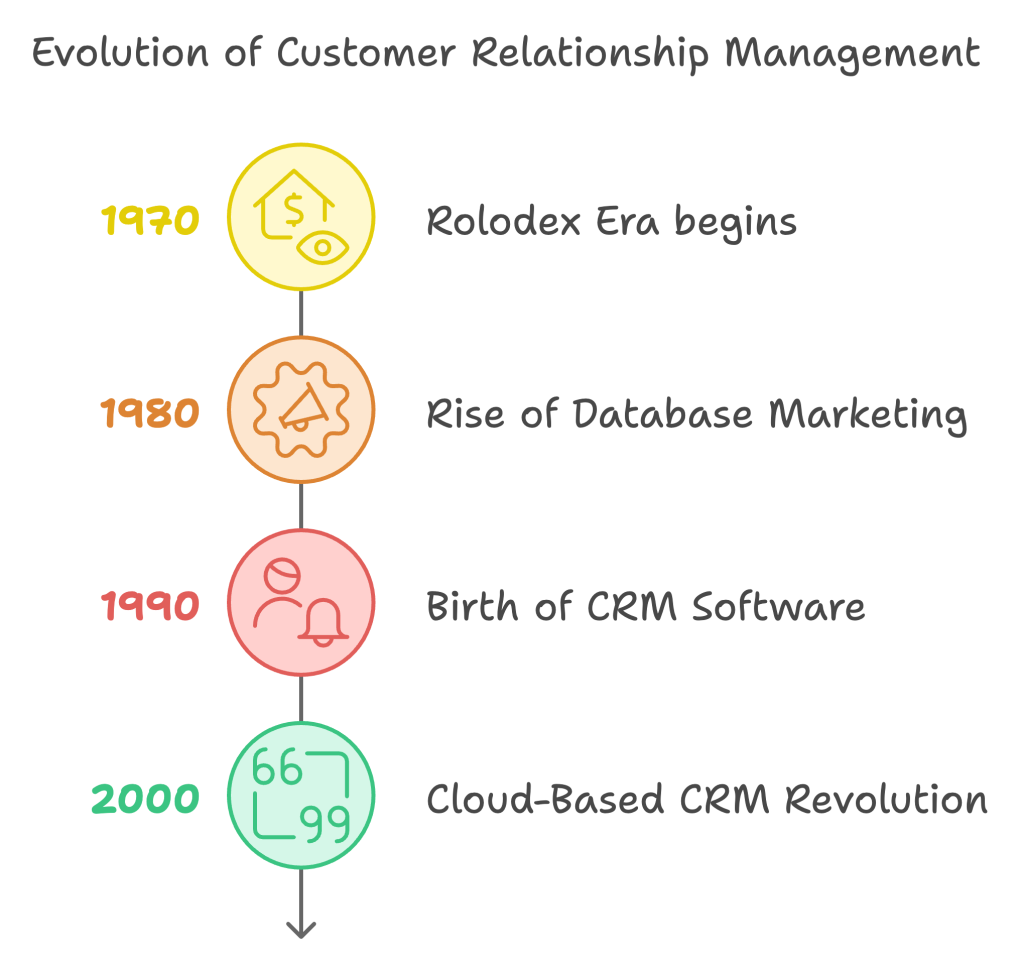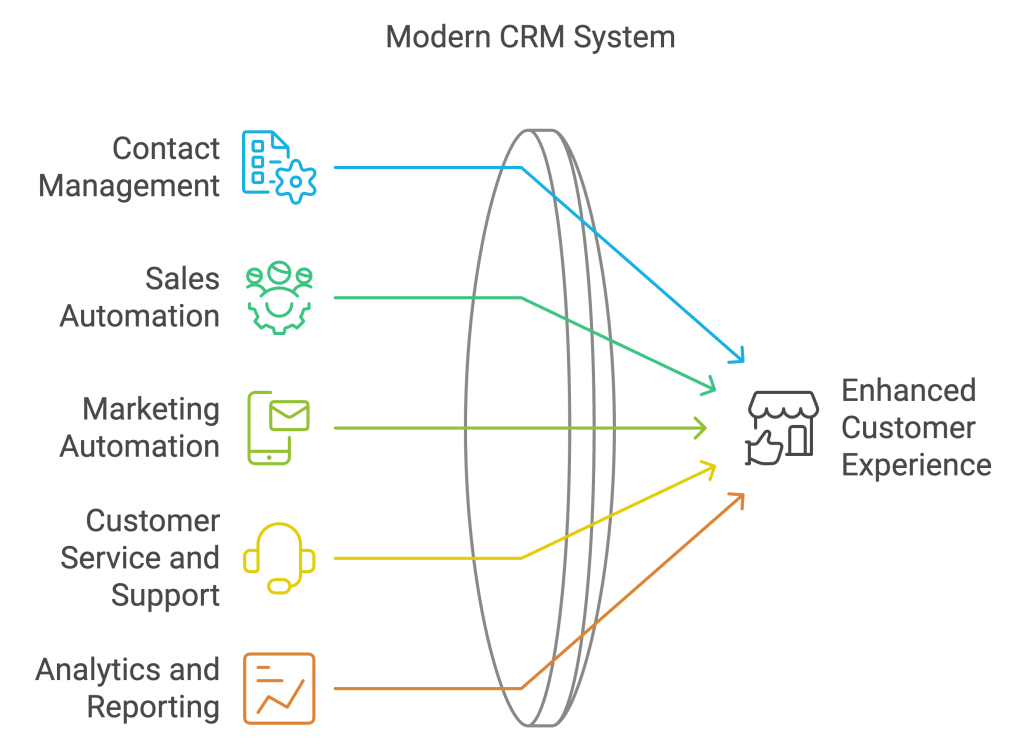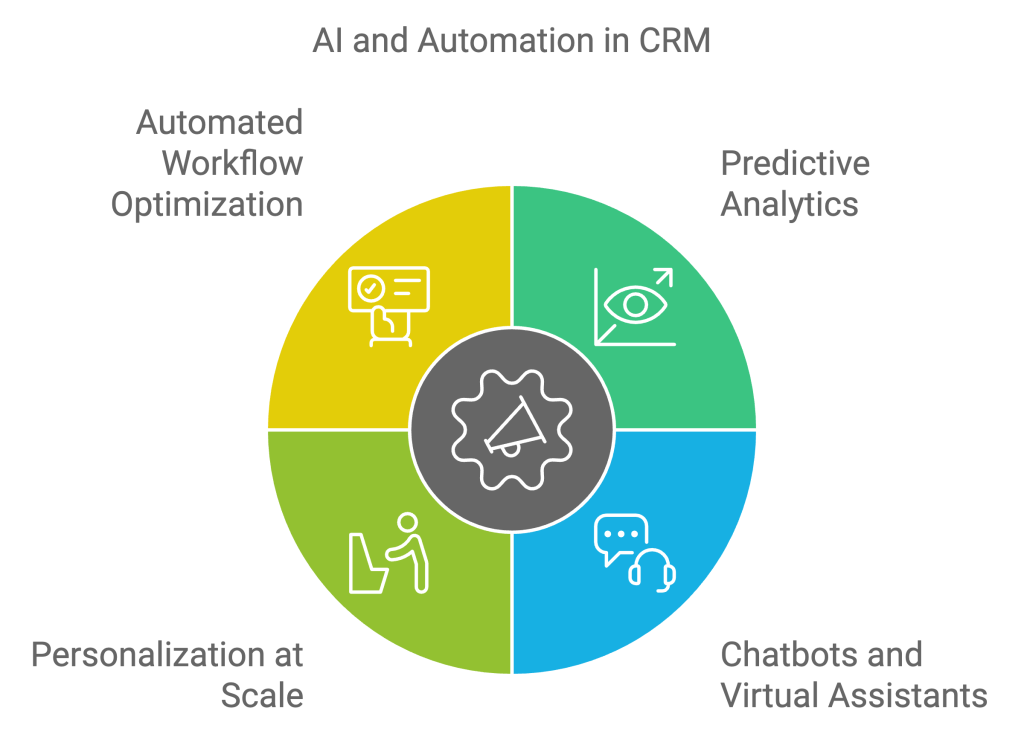In today’s hyper-competitive business landscape, the ability to effectively manage and nurture customer relationships can make or break a company’s success. Customer Relationship Management (CRM) has emerged as a crucial strategy and technology for businesses of all sizes. But how did we get here, and where is CRM headed? Let’s explore the fascinating evolution of customer relationship management, from its humble beginnings to the AI-powered future.
What is Customer Relationship Management?
At its core, Customer Relationship Management is a strategy for managing all your company’s relationships and interactions with customers and potential customers. It’s designed to improve business relationships, streamline processes, and increase profitability.
The objectives of CRM include:
- Improving customer satisfaction and retention
- Increasing sales and revenue
- Streamlining business processes
- Enhancing data analysis and decision-making
Modern CRM systems typically encompass three main types:
- Operational CRM: Focuses on customer-facing processes like sales, marketing, and service automation
- Analytical CRM: Emphasizes the analysis of customer data to improve business decision-making
- Collaborative CRM: Facilitates communication and collaboration across different departments and with customers
According to a recent study by [placeholder source], businesses that effectively implement CRM systems see an average increase of 25% in customer retention rates. Furthermore, for every $1 invested in CRM, companies see an average return of $8.71 (Source: Nucleus Research, placeholder).
The Historical Development of CRM
The concept of managing customer relationships is as old as commerce itself, but the systematic approach we now call CRM has a more recent history:
1. The Rolodex Era
Before the digital age, businesses relied on manual systems like rolodexes and file cabinets to keep track of customer information. This method was time-consuming and prone to errors, but it laid the foundation for organized customer data management.
2. The Rise of Database Marketing
In the 1980s, database marketing emerged as businesses began to collect and analyze customer information using computer systems. This marked the beginning of data-driven customer strategies.
3. The Birth of CRM Software
The 1990s saw the introduction of the first true CRM software platforms. These systems combined database technology with customer-facing operations, allowing businesses to track interactions and manage relationships more effectively.
4. Cloud-Based CRM Revolution
The 2000s brought cloud computing, making CRM more accessible and affordable for businesses of all sizes. Cloud-based CRM solutions offered flexibility, scalability, and reduced IT overhead.
The CRM market has grown exponentially over the past few decades. In 2020, the global CRM market size was valued at $41.93 billion, and it is projected to reach $96.39 billion by 2028 (Source: Grand View Research, placeholder).

Key Components of Modern CRM Systems
Today’s CRM platforms are comprehensive solutions that integrate various aspects of customer interaction:
1. Contact Management
The foundation of any CRM system, contact management allows businesses to store and organize customer information in a centralized database. This ensures that all customer-facing teams have access to up-to-date and accurate information.
2. Sales Automation
CRM tools streamline the sales process by automating tasks like lead scoring, opportunity tracking, and pipeline management. This automation can lead to a 14.5% increase in sales productivity (Source: Nucleus Research, placeholder).
3. Marketing Automation
Modern CRM systems often include features for creating, managing, and analyzing marketing campaigns across multiple channels. This integration allows for more personalized and effective marketing efforts.
4. Customer Service and Support
CRM platforms help manage customer inquiries, track support tickets, and maintain service-level agreements. This comprehensive approach to customer service can lead to a 35% increase in customer satisfaction (Source: Salesforce, placeholder).
5. Analytics and Reporting
Robust reporting tools allow businesses to gain insights from their customer data, measuring performance and identifying trends. These insights drive informed decision-making and strategy development.

AI and Automation in Customer Relationship Management
The latest frontier in CRM evolution is the integration of artificial intelligence and advanced automation:
1. Predictive Analytics
AI-powered CRM systems can analyze vast amounts of data to predict customer behavior, identify sales opportunities, and forecast trends. This capability allows businesses to be proactive rather than reactive in their customer interactions.
2. Chatbots and Virtual Assistants
AI-driven chatbots provide instant customer support, handle routine inquiries, and can even assist with sales processes. By 2024, Insider Intelligence predicts that consumer retail spend via chatbots worldwide will reach $142 billion—up from just $2.8 billion in 2019 (Source: Business Insider, placeholder).
3. Personalization at Scale
Machine learning algorithms enable businesses to deliver highly personalized experiences to customers across all touchpoints. This level of personalization can lead to a 20% increase in sales opportunities (Source: McKinsey, placeholder).
4. Automated Workflow Optimization
AI can analyze business processes and suggest or implement improvements, increasing efficiency and reducing manual work. This optimization can lead to significant time savings and improved productivity across teams.

Implementing CRM: Strategies for Success
While the benefits of CRM are clear, successful implementation requires careful planning and execution:
- Assess Your Business Needs: Before choosing a CRM solution, clearly define your objectives and requirements. What specific problems are you trying to solve?
- Choose the Right CRM Solution: Consider factors like scalability, integration capabilities, and user-friendliness when selecting a CRM platform. Don’t just go for the most popular option—find the one that best fits your unique needs.
- Data Migration and Integration: Plan carefully for transferring existing customer data into your new CRM system. Ensure that your CRM can integrate with other critical business tools you use.
- Training and Adoption: Invest in comprehensive training for your team. The success of your CRM implementation largely depends on user adoption and proper utilization of the system.
- Measure ROI and Continuously Improve: Regularly assess the performance of your CRM system against your business objectives. Be prepared to make adjustments and improvements as needed.
According to a study by Forrester, CRM implementations have a failure rate of 38%. However, businesses that follow best practices and invest in proper planning and training see success rates of over 80% (Source: Forrester Research, placeholder).
Embracing the Future of Customer Relationships
As we’ve seen, customer relationship management has come a long way from the days of Rolodexes and filing cabinets. Today’s AI-powered CRM systems offer unprecedented capabilities for understanding and serving customers. However, it’s crucial to remember that at its core, CRM is about people—not just technology.
The most successful businesses will be those that use CRM technology to enhance and support human relationships, not replace them. As you consider your own CRM strategy, think about how you can leverage these powerful tools to create more meaningful, personalized interactions with your customers.
Balancing Technology and Human Touch
While AI and automation can dramatically improve efficiency and provide valuable insights, the human element remains irreplaceable in building strong customer relationships. Here’s how you can strike the right balance:
- Use AI-powered insights to inform your human interactions, not replace them.
- Leverage automation for routine tasks, freeing up your team to focus on high-value, relationship-building activities.
- Continuously train your team on both the technical aspects of your CRM system and the soft skills needed for excellent customer service.
Expert Insights on the Future of CRM
To gain a broader perspective on where CRM is headed, we reached out to industry leaders. Here’s what they had to say:
“The future of CRM lies in predictive analytics and hyper-personalization. AI will enable businesses to anticipate customer needs before they even arise, creating proactive rather than reactive relationships.” – Dr. Sarah Johnson, CTO of TechCRM Solutions
“As CRM systems become more sophisticated, the human touch becomes more crucial, not less. The winners will be those who use technology to amplify their humanity, not replace it.” – Michael Chen, Customer Experience Consultant
“Integration is key. The next generation of CRM will seamlessly connect with every customer touchpoint, from IoT devices to social media, creating a truly holistic view of the customer journey.” – Lila Rodriguez, Head of Innovation at Global CRM Inc.
Assessing Your CRM Readiness
Before diving into a new CRM implementation or upgrade, it’s essential to assess your current state and readiness. Consider the following questions:
- How effectively do you currently manage customer data and interactions?
- What are your biggest pain points in customer relationship management?
- How tech-savvy is your team, and how open are they to adopting new tools?
- What specific goals do you hope to achieve with a CRM system?
- How well does your current technology stack integrate with modern CRM solutions?
To help you evaluate your CRM readiness more thoroughly, we’ve prepared a short interactive assessment. This quiz will help you identify your strengths and areas for improvement in customer relationship management.
Preparing for the Next Wave of CRM Innovation
As we look to the future, several emerging trends are set to shape the next evolution of CRM:
- Artificial Intelligence and Machine Learning: AI will become more sophisticated, offering deeper insights and more accurate predictions about customer behavior.
- Voice and Conversational Interfaces: With the rise of smart speakers and voice assistants, CRM systems will need to adapt to voice-based interactions.
- Augmented and Virtual Reality: These technologies could revolutionize how businesses visualize customer data and even interact with customers.
- Blockchain for Data Security: As data privacy concerns grow, blockchain technology could provide more secure and transparent ways of managing customer information.
- Internet of Things (IoT) Integration: CRM systems will increasingly pull data from IoT devices, providing even more comprehensive customer insights.
Your Next Steps: A Roadmap to CRM Success
Whether you’re just starting your CRM journey or looking to upgrade your existing system, here’s a roadmap to help you navigate the future of customer relationship management:
- Assess Your Current State: Use our CRM Readiness Quiz to identify your strengths and areas for improvement.
- Define Clear Objectives: Establish specific, measurable goals for your CRM implementation or upgrade.
- Research and Select the Right Solution: Explore various CRM platforms, keeping in mind your specific needs and future scalability.
- Plan for Data Migration and Integration: Ensure your new CRM system can seamlessly integrate with your existing tools and databases.
- Invest in Training and Change Management: Prepare your team for the new system with comprehensive training and support.
- Start Small and Scale: Begin with core features and gradually expand your CRM usage as your team becomes more comfortable.
- Continuously Measure and Optimize: Regularly assess your CRM performance against your objectives and make necessary adjustments.
To help you get started, we’ve prepared a comprehensive CRM Implementation Checklist. This downloadable resource outlines key steps for successfully implementing or upgrading your CRM system.
Embracing a Relationship-Centric Future
As we navigate the ever-evolving landscape of customer relationship management, one thing remains constant: the critical importance of building and maintaining strong customer relationships. The businesses that thrive in the coming years will be those that successfully leverage technology to create more personal, meaningful, and valuable interactions with their customers.
By embracing the evolution of CRM—from simple spreadsheets to AI-powered insights—you’re not just adopting a new technology. You’re committing to a philosophy that values each customer interaction, leverages data to provide better experiences, and ultimately drives business growth through stronger relationships.
The journey of CRM is far from over. As technology continues to advance, we can expect even more exciting developments in how businesses connect with and serve their customers. The question is: will you be at the forefront of this evolution, or playing catch-up?
Take the first step today. Assess your CRM readiness, download our implementation checklist, and start planning how you’ll transform your customer relationships for the digital age. Your customers—and your bottom line—will thank you.
Remember, in the world of business, relationships are everything. And with modern CRM, you have the power to make every relationship count. The future of CRM is bright, and it’s time for your business to shine.




